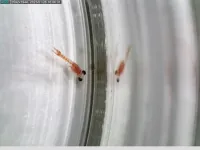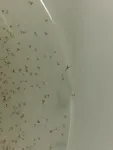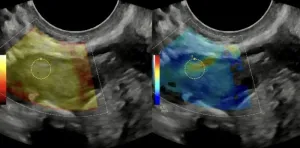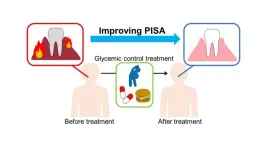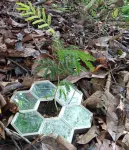(Press-News.org) Homing is an animal’s ability to navigate towards an original location, such as a breeding spot or foraging territory. Salmon and racing pigeons are famous for homing, but similar behaviors occur in groups as diverse as bees, frogs, rats, and sea turtles. There, homing individuals are known or suspected to rely on landmarks, the Earth’s magnetic field, or the sky’s pattern of polarized light to find their way back.
Another group known to display homing are cave-dwelling mysid shrimp, also known as possum shrimp for the pouches in which females carry their larvae. Results from previous studies suggested that mysids might use chemical cues to navigate to underwater caves, in the same way that coral larvae and coral-dwelling fish can distinguish between healthy and disturbed reefs.
“Here we show for the first time that mysids can tell the water-borne odor bouquet – its so-called chemical seascape – characteristic of their home cave apart from that of nearby caves,” said Dr Thierry Pérez, CNRS research director at the marine research station of Endoume near Marseille in France, and the lead author of a new study in Frontiers in Marine Science.
“This strongly suggests that these distinctive seascapes help them find their home cave again when they return from their nightly migrations.”
Cave dwellers
Pérez and colleagues studied the mysid species Hemimysis margalefi, which lives in sea caves in the northwestern Mediterranean. It forms dense swarms, with millions of individuals per cave. It is thought that individuals tend to remain faithful to their natal caves throughout their lifespan – between one and two years. At dusk, they move over hundreds of meters into open water to feed on algae, detritus and other zooplankton. At dawn, they return to the same cave to shelter from predators.
Divers sampled seawater from three caves in Calanques National Park off southern France, called ‘Fauconnière’, ‘3PP’, and ‘Jarre’. These lie between 11 and 24 meters underwater, and between 8 and 20 kilometers apart.
The researchers caught hundreds of adult H. margalefi from the Fauconnière and Jarre caves. For comparison, they also collected individuals of another mysid -- an unnamed species in the genus Leptomysis -- which doesn’t reside in caves but lives in shallow waters near Endoume station.
In each experimental trial, they placed a single shrimp at the origin of a Y-shaped channel. Each arm was connected to a 10-liter tank filled with seawater from one of the caves. This water flowed out of the tanks into the channel at a rate of 50 milliliters per minute, carrying any water-soluble metabolites.
Each shrimp was thus given the choice between water flows native to two caves, while time spent per arm was a proxy for their preference. Water from the 3PP cave was always used as the control. Between trials, the channel was emptied and rinsed with control water, after which the tanks were swapped between the arms.
In total, the researchers tested 286 individuals, of which 230 were H. margalefi and 56 were Leptomysis. Trials were conducted in the morning and afternoon, to test for any effects of the time of day on the shrimps’ preferences – but this turned out to have no effect.
No place smells like home
The results showed that H. margalefi strongly preferred water from their own cave. For example, individuals from Jarre cave spent 16 times longer in arms with Jarre water than in arms with 3PP water, while individuals from Fauconnière cave spent three times longer in arms with Fauconnière water than in arms with 3PP water.
In contrast, individuals from Jarre cave had no preference for Fauconnière over 3PP water, while individuals from Fauconnière cave had no preference for Jarre over 3PP water. Likewise, the non-cave dwelling Leptomysis never had a preference for one type of water over another.
The researchers used ultra-high-performance liquid chromatography coupled with high-resolution mass spectrometry (UHPLC-HR-MS) to reveal differences in metabolites between caves. These results showed that the seascape was mainly composed of natural peptides, fatty acids, steroids, and alkaloids, as well as anthropogenic pollutants. The chemical signature of Jarre water was highly distinct from that of Fauconnière water, while that of 3PP water was intermediate between these two.
The researchers hypothesized that sessile organisms like sponges, abundant in these caves and known to produce many specialized metabolites, are major contributors to the local seascape.
“We know that food availability in marine cave ecosystems largely depends on the daily migrations of zooplankton such as mysids. Our results suggest that any change in water quality or sessile fauna inside caves can alter their chemical seascape, with a likely negative impact on the functioning of the whole ecosystem,” said Pérez.
“This is concerning, because due to global change, mass mortality of sponges and corals are becoming more frequent.”
“We are currently following up on our results by trying to correlate the chemical seascapes from different caves with the biodiversity of sessile organisms living in them, focusing on the role of metabolites from sponges and corals.”
END
How does a tiny shrimp find its way home in a vast ocean? Study finds it’s down to their cave’s special smell
Possum shrimp use smell to trace their way back home thanks to local differences in ‘chemical seascape’
2024-09-17
ELSE PRESS RELEASES FROM THIS DATE:
‘Marine identity’ can help restore the ocean
2024-09-17
People’s deep connection with the ocean – their “marine identity” – can help us reset society’s relationship with the seas, new research led by Dr Pamela Buchan, from the University of Exeter, suggests.
A diverse, international group of marine researchers and practitioners met to discuss marine identity – based on testimony and photos from multiple countries.
The group included Diz Glithero of the Canadian Ocean Literacy Coalition, Dr Emma McKinley of Cardiff University who helped deliver the workshop, and others from across Europe, Africa, Indonesia, North America, and Australasia.
They found many common themes, including traditions ...
Evidence shows that estrogen blocker treatment does not increase the risk of coronary heart disease in breast cancer patients
2024-09-17
New evidence shows that extended estrogen suppression treatment using an aromatase inhibitors for hormone receptor-positive postmenopausal breast cancer is safe; it does not increase the risk of coronary artery calcification, a sign of active coronary atherosclerosis, as some prior studies had indicated. An article in the Canadian Journal of Cardiology, published by Elsevier, details the findings from a retrospective, cross-sectional observational study that investigated the association between the duration of aromatase inhibitor treatment and the severity of coronary artery calcification in postoperative breast cancer patients.
Coronary ...
Survey shows 25% of adults consider weight loss drug use without prescription
2024-09-17
COLUMBUS, Ohio – Injectable weight loss drugs are popular right now but can be hard to get because they are in short supply or too expensive without insurance. The result is that some people are skipping the doctor’s office and reaching out to potentially unreliable sources such as unlicensed online pharmacies or telehealth sites, which could expose patients to risks.
A new national survey from The Ohio State University Wexner Medical Center reveals 1 in 4 (25%) of 1,006 adults surveyed would consider using an injectable weight loss medication without consulting their doctor. The reasons ...
New treatment extends ovarian function in older mice
2024-09-17
Medication to reduce ovarian scarring helps extends overall health of reproductive system
Freezing eggs only addresses age-related infertility, not ovarian hormone loss. New treatment would ‘fix the root of the issue’
Findings also have implications for developing treatments for ovarian cancer
CHICAGO --- A woman’s ovaries are like a factory where eggs grow and produce hormones that regulate everything from menstruation and pregnancy to bone density and mood. As she and her factory age, production dwindles, and by the time she hits menopause ...
Getting to the root of the problem: Intensive diabetes treatment reduces gum disease inflammation
2024-09-17
Osaka, Japan – While the link between diabetes and periodontal disease is known, the impact of diabetes treatment on periodontal health is less well understood. Recent research published in Diabetes, Obesity and Metabolism demonstrates that periodontal inflammation can be positively affected just by receiving intensive diabetes treatment.
It is widely believed that there is an interrelationship between diabetes and periodontal disease. While it has been shown that treatment of periodontal disease improves blood ...
Researchers take power and efficiency of biological sensing to record level
2024-09-17
University of Arizona researchers have developed a new biological sensing method that can detect substances at the zeptomolar level – an astonishingly miniscule amount.
This level of sensing, immediately useful for drug testing and other research, has the potential to make new drug discoveries possible. Eventually, the advance could lead to portable sensors that can detect environmental toxins or chemical weapons, monitor food quality or screen for cancer.
A paper describing the results was published in the journal Nature Communications on Aug. 28.
Judith Su, associate professor of biomedical engineering and optical ...
Under-plant mirrors improve endangered plant survival and growth
2024-09-17
The most endangered plant species in the Mariana Islands, the legume tree Serianthes nelsonii, faces persistent threats in its recovery. These have been identified as a short lifespan of habitat seedlings and rapid death of saplings transplanted from conservation nurseries.
The Plant Physiology Laboratory at the University of Guam addressed this conundrum by improving growth and survival of Serianthes seedlings through strategically placed mirrors beneath deeply shaded seedlings to increase available ambient light. The resulting paper has been published ...
Widespread evidence for packaging-related chemicals in humans
2024-09-17
About this study: A new review is the first to reveal the extent of human exposure to food contact chemicals (FCC), with 3,601 chemicals used in food packaging and other food contact articles having been found in human bodies. The authors say this review also highlights significant gaps in biomonitoring and toxicity data.
---
In a new study, published in the Journal of Exposure Science and Environmental Epidemiology, scientists describe the widespread human exposure to food contact chemicals (FCCs). The research reveals which chemicals ...
Hardship early in life can affect health and longevity – even for marmots
2024-09-16
Key takeaways
The cumulative adversity index for people quantifies numerous measures of hardship, such as poverty and stress to understand health and longevity over the individual’s lifespan.
A similar tool could help scientists who study and want to conserve animal populations by identifying the most influential stressors to mitigate.
UCLA biologists have created the first cumulative adversity index for yellow-bellied marmots. They found that as in humans, adversity early on had lifelong consequences and reduced their life expectancy.
Adversity early in life can have permanent health consequences for people — even if their circumstances improve dramatically later on. ...
Chances of successful pregnancy are the same with embryo transfer on day three or five
2024-09-16
In IVF treatment, embryos are traditionally transferred in the uterus three days after fertilization. Due to improvements in laboratory techniques, this is now also possible after five days. It was assumed that this increases the chance of a successful pregnancy. A study by Radboud university medical center and Amsterdam UMC shows that the day of transfer does not influence the success rate of the IVF trajectory.
One out of thirty children in the Netherlands is conceived via in vitro fertilization, or IVF for short. In this procedure, ...
LAST 30 PRESS RELEASES:
Post-stroke injection protects the brain in preclinical study
Cardiovascular risk score predicts multiple eye diseases
Health: estimated one in ten British adults used or interested in GLP-1 medications for weight loss
Exercise to treat depression yields similar results to therapy
Whooping cough vaccination for pregnant women strengthens babies’ immune system
Dramatic decline in new cases of orphanhood in Uganda driven by HIV treatment and prevention programs
Stopping weight loss drugs linked to weight regain and reversal of heart health markers
Higher intake of food preservatives linked to increased cancer risk
Mass General Brigham–developed cholera vaccine completes phase 1 trial
First experimental validation of a “150-year-old chemical common sense” direct visualization of the molecular structural changes in the ultrafast anthracene [4+4] photocycloaddition reaction
Lack of support for people on weight loss drugs leaves them vulnerable to nutritional deficiencies, say experts
Dogs’ dinners can have greater climate impact than owners’
Are you ready to swap salmon for sprats and sardines?
1.6 million UK adults used weight loss drugs in past year
American College of Cardiology comments on new dietary guidelines for Americans
American Society of Gene & Cell Therapy and Orphan Therapeutics Accelerator partner to advance and commercialize promising rare disease treatments
One in 14 patients having day case surgery have new or worse chronic pain 3 months after their operation
New study highlights link between eviction rates and gun violence
Heatwaves heat up soil but not toxin levels in rice, study finds
Digital modeling reveals where construction carbon emissions really come from
Turning farm waste into water filters
New study shows how the spleen helps the immune system accept a transplant
New Mayo Clinic study advances personalized prostate cancer education with an EHR-integrated AI agent
Researchers identify novel therapeutic target to improve recovery after nerve injury
Microbes in breast milk help populate infant gut microbiomes
Reprogramming immunity to rewrite the story of Type 1 diabetes
New tool narrows the search for ideal material structures
Artificial saliva containing sugarcane protein helps protect the teeth of patients with head and neck cancer
Understanding the role of linear ubiquitination in T-tubule biogenesis
Researchers identify urban atmosphere as primary reservoir of microplastics
[Press-News.org] How does a tiny shrimp find its way home in a vast ocean? Study finds it’s down to their cave’s special smellPossum shrimp use smell to trace their way back home thanks to local differences in ‘chemical seascape’
